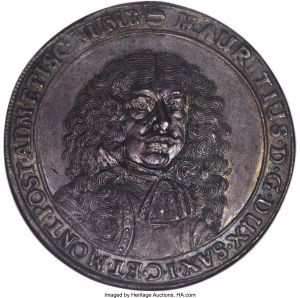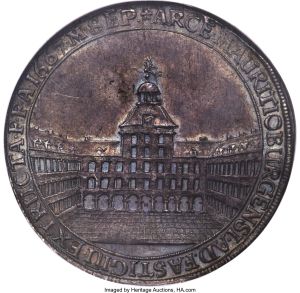Saxe-Zeitz-Naumburg 1667 thaler Dav-7666
This specimen was lot 31117 in Heritage sale 3105 (New York, January 2023), where it sold for $4,800. The catalog description[1] noted, "German States: Saxe-Zeitz-Naumburg. Moritz Taler 1667 AU58 NGC. A one-year type struck to commemorate the construction of Mauritzburg Castle. Exhibiting surfaces heavily patinated with a deep ash-clay color, a lagoon blue hue in the windows and arches of the castle, and a gold shade backlighting the horizon. From the Cape Coral Collection, Part II." This rare type is listed in the SCWC under its Davenport number along with a double thaler (Dav-7666A). The two are the only coins listed for this branch of the Saxon duchies, which was created fro Moritz and lapsed in 1718. The family also ruled parts of Henneberg.
Wikipedia comments,
"The Duchy of Saxe-Zeitz (German: Herzogtum Sachsen-Zeitz) was a territory of the Holy Roman Empire established in 1656–57 as a secundogeniture of the Electoral Saxon house of House of Wettin. Its capital was Zeitz. The territory fell back to the Wettin electoral line in 1718. On 20 July 1652, the Saxon elector John George I stipulated in his will that, while the electoral dignity passes to his eldest son John George II, his three younger brothers should receive secundogeniture principalities upon his death. After the elector died on 8 October 1656, his sons concluded the "friend-brotherly main treaty" in the Saxon residence of Dresden on 22 April 1657 and a further treaty in 1663 delineating their territories and sovereign rights definitely. These treaties created three duchies: Saxe-Zeitz, Saxe-Weissenfels and Saxe-Merseburg.
Prince Maurice, the fourth-oldest son received the districts of Zeitz, Naumburg and Haynsburg in the former Bishopric of Naumburg-Zeitz which in 1562 had been secularized in the course of the Protestant Reformation. He also received the city of Schleusingen in 1660, which had once been the residence of the extinct Counts of Henneberg, together with the districts of Suhl and Kühndorf. Duke Maurice resided in the city castle at Naumburg until his new seat at Moritzburg Palace in Zeitz had been completed. The only rulers were Duke Maurice of Saxe-Zeitz and his son Duke Moritz Wilhelm of Saxe-Zeitz. This line was the first of the three Saxon secundogenitures to die out in 1718, when the only male heir, Prince Christian August, joined the clergy."
Recorded mintage: unknown.
Specification: 28.99 g, silver.
Catalog reference: Dav-7666, Schnee-1130.
- Cuhaj, George S., and Thomas Michael, Standard Catalog of World Coins, 1601-1700, 6th ed., Iola, WI: Krause Publications, 2014.
- Davenport, John S., German Secular Talers, 1600-1700, Frankfurt: Numismatischer Verlag, 1976.
- Gernot Schnee, Sächsiche Taler, 1500-1800. Frankfurt Am Main, P. N. Schulten, 1982.
- [1]Cristiano Bierrenbach, Warren Tucker and Sam Spiegel, 2023 January 9 NYINC World & Ancient Coins Platinum Session and Signature® Auction - New York #3105, Dallas, TX: Heritage Auction Galleries, 2022.
Link to:

